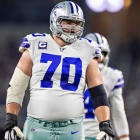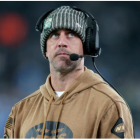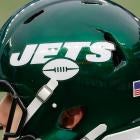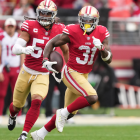
Through the first two games of the season, the Pittsburgh Steelers offense ranks 31st in yards and 32nd in points. They haven't been any better on a per-play or per-drive basis, checking in 30th in yards per play, 31st in plays per drive, and 32nd in points per drive.
They've seen 68% of their drives end in an interception, lost fumble, or punt -- the second-worst rate in the league, according to TruMedia. An incredible 56% of their drives have ended in a three-and-out. Again, that is the second-worst mark in the NFL. A full 50% of their plays have gained zero or negative yards. That's by far the highest rate in the league.
Naturally, they rank 25th in TruMedia's version of expected points added (EPA) per rush attempt and 32nd in EPA per pass attempt, and, again, 32nd in overall EPA/play. It would be difficult to claim with a straight face that any offense in the league has performed worse to date.
Ahead of their "Sunday Night Football" date wit the Las Vegas Raiders, it's worth examining what on earth is going on here -- especially given that many preseason prognosticators had high hopes that the Steelers would take a step forward offensively this year.
We can't start anywhere else but the offensive line. Through two weeks, it's possible that the Steelers have gotten worse line play than any team in the league except for the Jets. How bad has it been? Well, on 31 rushing attempts, Steelers running backs have gained a total of ZERO yards before first contact, according to TruMedia. Najee Harris and Jaylen Warren have made it beyond the line of scrimmage before being touched by a defender on just eight of their carries, a pathetic 26.7% rate. And this is despite the fact that exactly ONE of Pittsburgh's 31 rushing attempts has come with eight or more defenders in the box. That 3.2% rate is the lowest in the NFL.
Worse yet, the offensive line has yielded pressure on Kenny Pickett on an astronomical 45.8% of his dropbacks. That's the fifth-worst mark in the league despite the fact that the Steelers have faced an opponent's blitz rate of just 22.9% -- a bottom-10 blitz rate. So, opponents are rarely sending extra rushmen after the quarterback, and the Steelers are allowing him to be heavily pressure anyway. Needless to say, that is not a good combination.
Compounding these issues is the fact that the design of offensive coordinator Matt Canada's offense is not providing any easy answers. Kenny Pickett has had to throw into a tight window on 22.1% of his passing attempts, according to NFL.com's NextGen Stats. That's the third-highest rate among 32 qualified quarterbacks. With wide receiver Diontae Johnson having left the team's Week 1 loss with an injury, the Steelers are short on pass-catchers who can create separation. George Pickens has a ton of talented, but his best skill is winning in contested catch situations. There haven't been enough layups available for the Steelers through the air.
As a result, Pickett has had to hold onto the ball for too long. He's released the football within 2.5 seconds of the snap only 38.2% of the time so far. That's a higher rate than only Bryce Young, Russell Wilson, Justin Fields, Zach Wilson, Deshaun Watson and Jalen Hurts. All of those quarterbacks are either very young, extremely mobile, or both. Pickett is also young and he can move around a bit, but he doesn't fit that same mold.
The Steelers need to get him some rhythm passes so he's not always left to create things on his own outside the structure of the offense. Especially because those attempts to do so have not been very fruitful. Typically, when players take longer to throw the ball, the trade-off is that they are more willing to push it down the field in search of big plays. But that has not been the case for Pittsburgh so far. Pickett's 6.6-yard average depth of throw is bottom 10 in the NFL, and his 6.5% explosive pass rate checks in ahead of only those of Fields, Daniel Jones and Young.
Pickett has also just been extremely inaccurate when he's tried to throw in rhythm. According to TruMedia, he's been off target with 15.8% of his throws. That's worse than every quarterback except for Jordan Love, Watson and C.J. Stroud. Some of that is his own issues with ball placement, but some of it is, again, the design of the offense and the fact that he is rarely put it advantageous positions. Pickett's 81.9% true dropback rate (the share of his passes that are not play-action passes or screens) is by far the highest in the NFL. Using more play-action or screen passes would give him some easier throws, but the Steelers simply don't incorporate those plays into their offense at a high rate.
One of the biggest indicators that things are just not working on any level is that even when the Steelers have utilized tactics that are supposed to be beneficial for an offense, they have still struggled. NFL teams are generally more efficient when they use pre-snap or at-the-snap motion, for example, but the opposite has been the case for Pittsburgh. The Steelers have used motion more often than almost every NFL team, but their motion is so inert and non-threatening that they've actually been less productive on those plays than the ones where they have kept their skill players static. The league average team has recorded a success rate (a successful play is one where the offense has a higher expected points average at the end of the play than the start of it, per TruMedia) of 45.7% on plays including motion; Pittsburgh's checks in last in the NFL at 26.3%, by comparison.
All of this is obviously extremely discouraging, and having to go up against a Vegas defensive front that features star edge rusher Maxx Crosby doesn't provide much reason for hope of an immediate turnaround. But the Raiders have also allowed extremely efficient offensive performances to both the Broncos and Bills so far this year, and the team's secondary is beatable. If the Steelers can figure out a way to get more easy answers in the passing game, perhaps they can turn things around there, and use that success to provide more space for the run game.


















